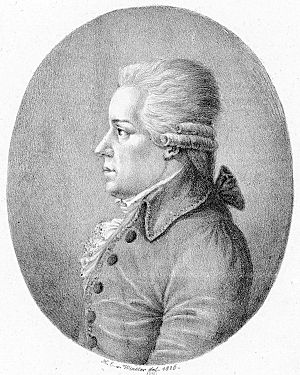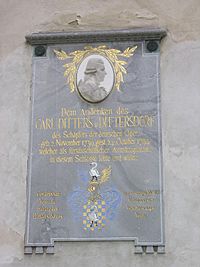Carl Ditters von Dittersdorf facts for kids
Carl Ditters von Dittersdorf (born November 2, 1739 – died October 24, 1799) was a famous Austrian composer and violin player. He was also a forest expert. He was good friends with two other very famous composers: Haydn and Mozart.
Contents
Life
Early Years (1739–1764)
Carl Dittersdorf was born in Vienna, Austria. His original name was Johann Carl Ditters. His father worked as a tailor for the Austrian army. When Carl was six, he started learning the violin. His family had enough money to send him to a good school and pay for private music lessons.
In 1751, when Carl was about 12, Prince Joseph of Saxe-Hildburghausen noticed his talent. The prince hired him to play in his court orchestra. Carl then studied violin with Francesco Trani and learned how to compose music from Giuseppe Bonno.
Later, the Austrian Empress hired Dittersdorf for her own orchestra. In 1761, he became a violinist in the Imperial Theatre orchestra. By 1762, he was its conductor! During this time, he met Christoph Willibald Gluck, another important opera composer. In 1763, Carl traveled to Italy with Gluck. This trip really inspired his future music. Back in Vienna in 1764, he met the great Joseph Haydn. They became very close friends.
A New Job and a New Name (1764–1774)
In 1764, Dittersdorf became the music director (called Kapellmeister) for a Hungarian nobleman and bishop named Ádám Patachich. The next year, he met Philipp Gotthard von Schaffgotsch, a prince-bishop who was creating a cultural center in Javorník, which is now in the Czech Republic.
Carl accepted a job as the court composer there in 1771. He wrote most of his best music during the next twenty years at this court. He created symphonies, string quartets, and funny operas. In 1773, the prince-bishop gave him a new job that required him to have a noble title. So, Ditters went to Vienna and was given the noble title "von Dittersdorf." From then on, his full name was Carl Ditters von Dittersdorf.
Later Life
Johann Baptist Wanhal was one of Dittersdorf's most famous students. Around 1785, Dittersdorf, Haydn, Mozart, and Wanhal often played string quartets together. Dittersdorf played the first violin, Haydn the second violin, Mozart the viola, and Wanhal the cello. Imagine four of the greatest composers of their time playing music together!
In 1794, after 24 years, Dittersdorf had a big disagreement with the prince-bishop and had to leave his palace. The next year, Baron Ignaz von Stillfried invited him to live in his castle in southern Bohemia. For the last ten years of his life, Carl worked on his operas and prepared his music to be published.
He died in 1799 and was buried in the town of Deštná. He finished writing his autobiography just three days before he passed away.
Music Style and Fame
Dittersdorf's early music helped shape his later works. His symphonies and chamber music often focused on beautiful, flowing melodies. He didn't always develop musical themes as much as some other composers.
After writing some early Italian comic operas, he started writing German ones called Singspiele. His opera Doktor und Apotheker (The Doctor and the Apothecary) was a huge hit in 1786. It was performed all over Europe!
He wrote about 120 symphonies. Twelve of these were special "programmatic" symphonies based on stories from Ovid's Metamorphoses (ancient Roman poems about transformations). Only six of these have survived, and they have been recorded for people to listen to today.
Dittersdorf also wrote many other types of music, including oratorios (large musical works for voices and orchestra), cantatas (vocal works with instrumental accompaniment), and concertos (pieces for a solo instrument and orchestra). He wrote two concertos for the double bass and one for the viola. He also composed string quartets, other chamber music, and piano pieces. His life story, called Lebenbeschreibung (Description of My Life), was published in 1801.
Works
Concertos
Carl Dittersdorf wrote many concertos for different instruments. These are pieces where one or more solo instruments play with an orchestra.
- 18 concertos for Violin
- 5 concertos for Viola
- 2 concertos for Contrabass (Double Bass)
- 1 concerto for Viola and Contrabass
- 5 concertos for Oboe
- 1 concerto for Flute
- 1 concerto for Cello
- 1 concerto for Piano
Symphonies
Dittersdorf wrote around 120 symphonies that we know for sure are his. Many more might be his work too. Most of his symphonies are kept as handwritten copies.
- Sinfonia nel gusto di cinque nazioni (Symphony in the style of five nations) (1767)
- 6 Symphonies Op. 1 (1768)
- 6 Symphonies Op. 4 (1769)
- The Periodical Ouverture (1769)
- His most famous symphonies are the six based on Ovid's Metamorphoses:
* Symphony No. 1: "The Four Ages of the World" * Symphony No. 2: "The Fall of Phaeton" * Symphony No. 3: "The Metamorphosis of Acteon Into a Stag" * Symphony No. 4: "The Rescue of Andromeda by Perseus" * Symphony No. 5: "The Petrification of Phineus and his Friend" * Symphony No. 6: "The Transformation of the Lycian Peasants into Frogs"
Chamber Music
Chamber music is written for a small group of instruments, usually one player per part.
- 15 Divertimenti (fun, light pieces)
- 6 String Quintets (for two violins, viola, cello, and double bass)
- 6 String Quartets (for two violins, viola, and cello)
- Many Trios (for three instruments) and Duets (for two instruments)
- 136 pieces for Piano
Operas
Dittersdorf wrote many operas, which are plays set to music.
- Amore in Musica (Love in Music) (1766)
- Arcifanfano, rè de’ Matti (Arcifanfano, King of the Fools) (1774)
- Doktor und Apotheker (The Doctor and the Apothecary) (1786) - This was his most successful opera.
- Die Liebe im Narrenhaus (Love in the Madhouse) (1787)
- Das rote Käppchen (Little Red Riding Hood) (1788)
Oratorios
Oratorios are large musical works, usually based on religious stories, performed without costumes or staging.
- Isacco figura del Redentore (Isaac, Figure of the Redeemer) (1766)
- Davide penitente (David the Penitent) (1770)
- Giobbe (Job) (1786)
Other Works
He also composed many cantatas (vocal pieces with instruments) and sacred music, including masses and requiems for church services.
See also
 In Spanish: Carl Ditters von Dittersdorf para niños
In Spanish: Carl Ditters von Dittersdorf para niños
- Wenzel Müller
- Johann Baptist Wanhal




